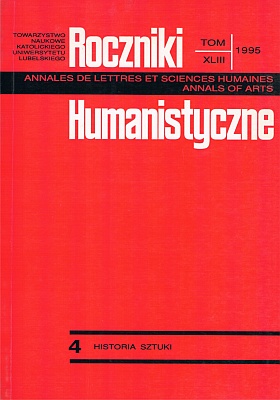A Report on the Debates and Discussion at the Seminar Organized by the Chair of of the Theory of Art and History of Artistic Doctrines in Kazimierz Dolny in November 1992
Abstract
A seminar entitled Matejko and History took place in Kazimierz Dolny in November 1992. Its organizers were: Chair of the Theory of Art and History of Artistic Doctrines of the History of Art Section of the Catholic University of Lublin and the Lublin division of the Association of the Historians of Art. The seminar was initiated within the frameworks of the research programme Ideology of Artists and the Theory of Art in 19th-20th c., and carried out by the Chair under prof. Elżbieta Wolicka.
The seminar was occasioned by the issue of Jarosław Krawczyk's book Matejko and History edited in 1990 by the Institute of Art of PAN (Polish Academy of the Sciences). We publish the seminar materials in the first part of the present fascicle of "The Humanities Annuals of KUL". The book in question while putting into practice the famous calling of Wojciech Gerson of 1883 which postulated that "each work be analyzed according to what was probably meant by the artist, and not what some critic would like it to mean". The book is an attempt at a reconstruction of the historical imagination of this painter so important for Polish art. At the same time, on the basis of some selected works (Skarga's Sermon, Battle of Grunwald, Prussian Homage, May Constitution), it revises many earlier judgements on Matejko's painting. The author reviews "historical" and "clearing" works of the painter within the frameworks of a finite and closed whole, which allows him to place the painter in the context of the intellectual formation and artistic situation of the day. Krawczyk turns our attention to numerous ideological manipulation which Matejko's output was many times subject to.
The book Matejko and History was intended by the seminar organizers to become a pretext to take up a broader topic, namely, the question of an academic tendency in Polish art of the 19th century, especially the work of artists who drew their inspiration from history. The problem of studying styles of reception of art of the past age. It is in this perspective that Marek Wacławek (Matejko Read Anew) sought to show the book in his introduction to discussion. He put it together with the works of Maria Poprzęcka (Imagined Time. On the Manners to Relate in Polish Painting of the 11th Century, Warszawa 1986) and Waldemar Okoń (especially with his book Art and Narration. On the Visual Narration in Polish Painting of the Second Half of the 19th Century, Wrocław 1988, and the article On Some Criteria of Evaluating of Polish Art in the 19th Century, that is about the unwritten history of the Polish painting of the 19th century, published in the volume Art and Value, ed. by M. Poprzęcka, Warszawa 1988). We have reprinted Marek Wacławek's text in this collection. The conclusions that one can draw from it as well as from the discussion at the seminar on the first day turned the participants' attention, counter to assumptions and hopes, to Matejko's painting. What is more, one can say that eventually the meeting was dominated by the considerations concerning Jarosław Krawczyk's book. The fact that its author was present made the participants pinpoint questions and objections which come up after reading this precious publication. Doubts arose when it came to apply Krawczyk's method to the interpretation of Matejko's paintings which he had omitted. Juliusz Gałkowski, in a short text, expressed his doubts as to the efficiency of "reading" Matejko's painting in this manner. He said that the method brought about the expected effects only in the case of huge compositions of the artist, the composition which belong to "the great cycle" (and only the selected ones, as those mentioned before). In order to prove this judgement one should answer the question whether Matejko's style of narration, creating tension between the centre of the painting and its peripheries, could be noticed in other works of the painter than those mentioned by Jarosław Krawczyk. And what about the other artists of that time? Dorota Kudelska considered some optional answers to this question. She suggested that we might profit from an analysis of the list of themes which Matejko assigned to his pupils. The author of "the largest painting" consequently remained the hero of the seminar, till the end when Małgorzata Kitowska-Łysiak reminded some casual remarks made by Wilhelm Feldman (here in the role of a historian of Polish literature) about the perception of Matejko's achievements.
Henryk Słoczyński began the second day of the meeting. He said about the relations between Matejko and Józef Szujski and "the Cracow school". In his paper Sadness of the Penitents (On Matejko's and Szujski's Historical Views), which we quoted on the previous pages, the author presented, among other things, his doubts as Jarosław Krawczyk's interpretation of Matejko's "great cycle". Słoczyński did not consent to a thesis about a representative character of the work opening (Skarga's Sermon) and closing (3rd May Constitution) "the great cycle" for its whole. At the same time he opposed to stressing (in the "cycle" perspective) the penitential aspect. He also discussed the way Krawczyk presented Jóżef Szujski. Thus an exchange of views was initiated and it found its completion in the address of the author of the controversial book. His address was entitled Without a Hair Shirt and directed mainly to Henryk Słoczyński. We have quoted the whole text of Jarosław Krawczyk's answer. It is a direct reaction to a concrete opponent, and an emphatic summing up of the whole seminar.
Copyright (c) 1995 Roczniki Humanistyczne

This work is licensed under a Creative Commons Attribution-NonCommercial-NoDerivatives 4.0 International License.





